We equip the self-leveling floor with our own hands: installation instructions
Leveling the floor is the most important and most difficult task of any repair. It is difficult to notice the slight curvature of the ceiling or walls with the naked eye, but a slight drop in the floor will not only be felt immediately, but will also affect the entire interior - the furniture will be skewed! Of course, the most reliable proven way to make the floors perfectly even is a complete screed, but what if there is no 28 days left to wait for drying, or you can’t do such a load on the floor? There is an exit! In European countries and overseas, it is almost impossible to meet in industrial buildings the usual concrete or wooden floor - only bulk. Similar to liquid linoleum, durable, environmentally friendly and incredibly practical. And, at the same time, completely non-slippery and pleasant to the touch. For good reason the bulk floor is called "liquid linoleum." Want to learn more about this interesting technology?
If self-leveling mixtures are used to level the floor, this floor is called bulk. And today there are at least two types of it - a topcoat, which is as soft as linoleum, but much stronger and more durable, and quick-hardening screed, on a gypsum or cement base, under a different topcoat. And the technology of their manufacture is the same - we will study it now.
Content
Stage I. Preparation for work
When working with flooded floors, be sure to wear protective clothing. The fact is that a modern self-leveling floor is a truly environmentally friendly material, but in the process of pouring it releases toxic volatile substances, thus losing fluid and drying out. It’s just impossible to breathe them, and the fact that someone on the video instructions almost barefoot makes the bulk floors is only on the video, and repeating such tricks is dangerous to health.
Here are the tools you need for the device of the bulk floor: a drill, mixer, two large containers of 40-50 liters and a needle roller.
Stage II. We select a mixture
Self-leveling mixtures, on the basis of which they make the bulk floor, have a number of valuable advantages:
1. The simplicity of the device
2. High technological qualities.
3. The minimum drying time.
The only difficulty in using them is to make such a floor quickly so that the mixture does not have time to dry.
According to the type of binder and the characteristic of the bulk floor itself, four types are distinguished today:
- Polyurethane. Such floors have special mechanical strength and resistance to chemical aggressive substances. The unique elasticity, impact resistance and resistance to temperature extremes have made this type the most popular in medical institutions and workshops, where there is a risk of a heavy object falling and there are vibrations. Those. any dynamic effects, which for a regular screed are often destructive.
- Epoxy. Such bulk floors are famous for their hardness, rigidity and durability. They are also resistant to various acids and alkalis, but already slightly less than polyurethane. Easy to clean, wash by any means, delight with a wide range of colors and are ideal for those rooms where usually the temperature ranges from 0 ° C to + 15 ° C.Epoxy floors can withstand mechanical loads, but not too elastic, unfortunately.
- Methyl methacrylate floors not particularly resistant to external influences, and do not differ in strength. But they are environmentally friendly, adhere perfectly to the base and feel great in the range from -70 ° C to + 150 ° C. And this is a huge plus for builders - such a floor can be safely flooded even in severe frost, and still in a couple of hours it will be completely ready for use. That's just such a styling requires a certain professionalism.
- Cement-acrylic bulk floors made of mixtures, which include cement and a polyacrylic copolymer. Resistant to constant exposure to water, aggressive household chemicals and intense mechanical stress. The surface of these floors is matte, pleasant to the eyes and has enhanced anti-slip properties.
You can read about different types of mixes for bulk floors and their characteristics in our review article about the best manufacturers of material:https://floor.expertexpro.com/en/pol-pokritiya/nalivnoy-pol-luchshiy-proizvoditel.html.
Here is an example of a device of this gender:
In the manufacture of the finishing bulk floor, self-leveling mixes used on the basis of epoxy and polyurethane binders. Such floors are most popular in commercial and industrial premises. As for private construction, it is often polyurethane self-leveling floors that are arranged, due to their lightness and durability, as well as the absence of any resins in their composition. And to make them not necessarily monophonic:
And separately we want to highlight such a kind as 3D bulk floors - A bright modern trend that is actively conquering the world. At the heart of this design are the same ordinary epoxy and polyurethane mixtures, but only transparent and drenched on the selected fabric with a pattern. There are several ways to device it, and about this we have a separate interesting article on the portal.
Stage III. Foundation preparation
It is important to clean the old floor as clean as possible - without debris, dust and stains. Next, you need to find the highest point of the floor and the lowest, and by subtracting the values of one from the values of the other, estimate the height difference. It will be necessary to start from the obtained value in calculating the thickness of the future bulk screed.
Next, be sure to check the base for humidity. Here's how to do it: cover one meter of the floor with a single square piece of film, and slightly raise the center, and press the edges well with slats with a load. And look at the result:
- If the bubble has fogged up during the day, the bulk floor can not be done now.
- If the first drops appear only after three days, smooth the floor well.
- If on the fifth day there is no noticeable condensation, you can safely proceed to the flooding
- floor self-leveling mixture.
Here's how to properly prepare the floor base before screeding:
- Remove the old coating.
- We clean the floor of debris and dirt.
- Hammer down all easily peelable pieces of concrete.
- Carefully close up all cracks and troughs.
- We determine the curvature of the floor by a laser or water level.
- Well primed surface for good adhesion and protection against mold.
Before using self-leveling mixtures, the surface must be primed - for the sake of better adhesion and protection of the concrete base from moisture absorption. It is convenient to prime the floors with a long-nap roller, abundantly impregnating the entire surface with a compound for deep penetration. Only after the primer is completely dry can the damper tape be fastened throughout the room.
It is extremely undesirable to apply bulk floors to a wooden base, because any liquid mixture contains water, and water is absorbed into the wood very quickly. No primers will help! The same applies to any other basis: no matter where you make the floor, the surface of the entire area should have 100% water-repellent properties.After all, even capillary suction can cause irreparable harm: in some places the applied solution will be thicker than necessary, due to water loss, it will not be able to spread enough and will not dry out synchronously with the entire remaining area. Bottom line: a completely uneven surface, with warpage and noticeable "waves". And then dismantling the finished bulk floor is almost an unrealistic task. It is easier to reload, paying this time twice as much as the originally planned budget. A rare exception is a good waterproofing of the wooden floor before pouring the mixture.
If you have an uneven concrete subfloor, using self-leveling mixes is a good way to prepare the surface for your finish. Read about the use of this material on our website:https://floor.expertexpro.com/en/viravniv-stazhka/vyravnivanie-pola-samovyravnivayushhejsya-smesyu.html.
Stage IV. Installation of reference beacons
For the bulk floor, there are beacons that are completely different from the guide profiles for the screed. Usually these are tripods, metal devices with marks on which the floor is poured. Like here:
Then we remove them. If there are none, then simply draw a line along the perimeter of the walls and fill the solution along it, but it’s more difficult.
Step V. Knead the solution.
Self-leveling mixtures consist of a filler and a binder, which may be polymers or cement. Plus, a variety of additives that are designed to improve and correct the desired properties of the compositions. And occasionally - coloring matter. And all this is connected quickly by substances evaporating in contact with water. That is why you have only 20 minutes after mixing the solution, because after a while it will simply become petrified.
The solution itself should turn out to be liquid, like sour cream, except when special mixtures are used:
Stage VI. Fill the floors
The very essence of using self-leveling mixtures is simple: the prepared base is poured, and the ideal horizontal surface is formed itself. Such a property of the liquid - even a huge lake with its underwater uneven relief on top is still as smooth as a mirror.
If you need to protect the floor from moisture and exposure to aggressive chemicals, then pay attention to bulk epoxy floors. Read more about the use of such a coating in the material:https://floor.expertexpro.com/en/pol-pokritiya/nalivnoi/nalivnye-epoksidnye-poly.html.
Ready mixes need to be poured in strips, and leveled by the usual rule. At this time, air lenses appear inside the mixtures that did not have time to exit during the pouring process due to the strong tension of the material. If you do not get rid of them now, later they will create bubbles over the entire area, which will look awful, not to mention the qualities of the bulk floor itself. Fortunately, it’s easy to prevent this - just go with a needle roller right away. If you didn’t have such a tool, then use a regular brush with hard sparse bristles.
The surface tension of self-leveling mixtures is negligible, due to which they freely spread over the unevenness of the floor and form a relatively flat surface. Moreover, you can also fill in the entire floor at once, without dividing it in any way - either into islands or into sections, and therefore you will not have to close up the joints. If you are not sure what you can do, then all the same stripes.
The ideal temperature for pouring this floor is + 15 ° C. The bulk floor should dry evenly, without direct sunlight or drafts.
That's all the subtleties of the device of the bulk floor.

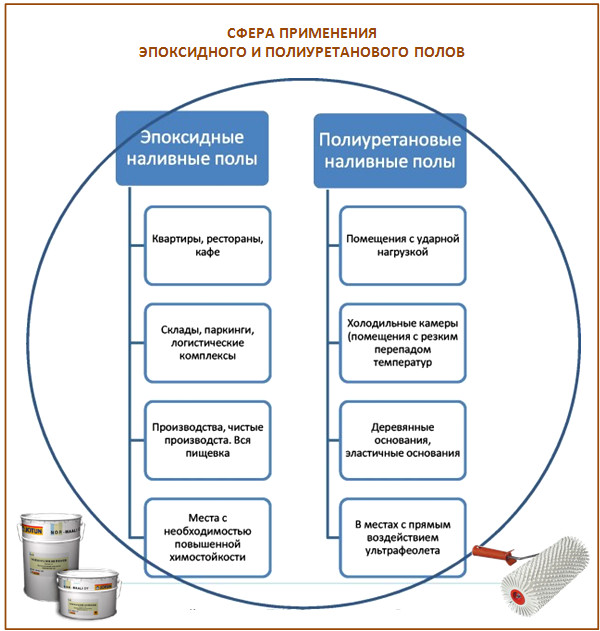

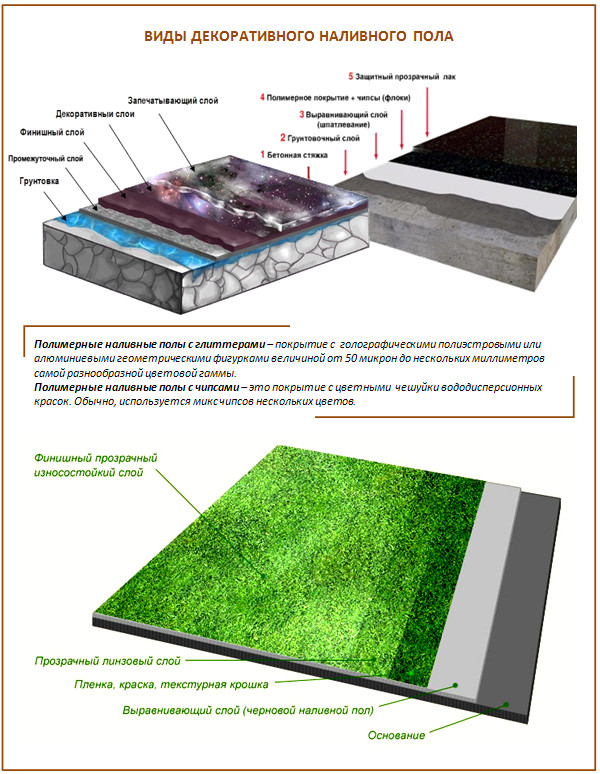
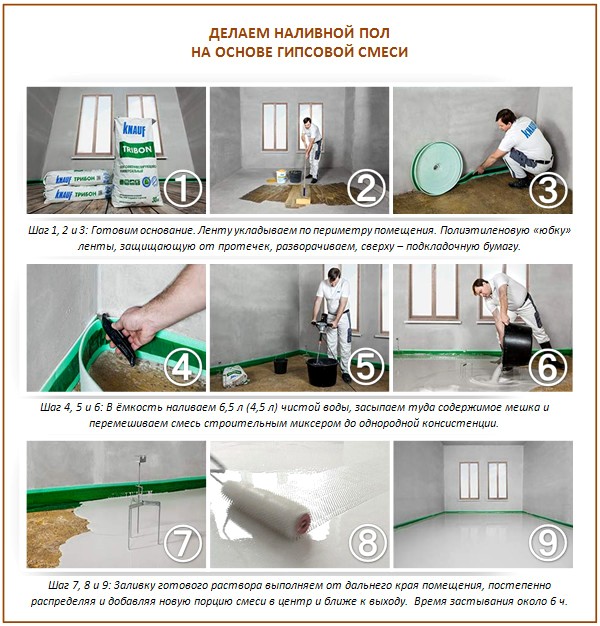
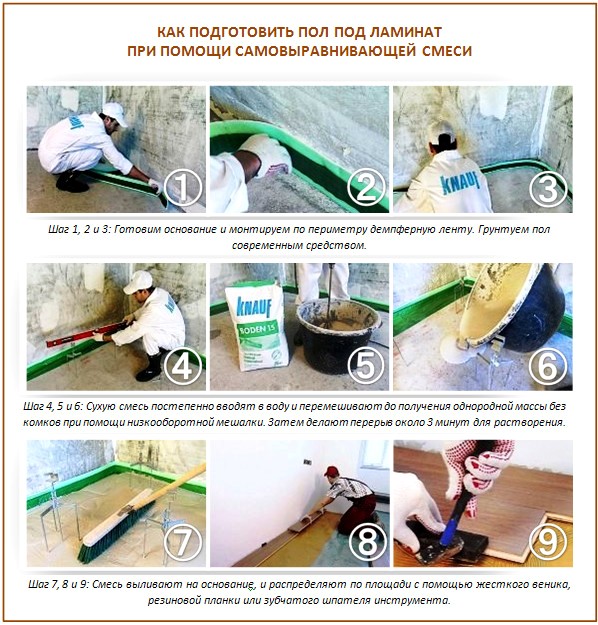



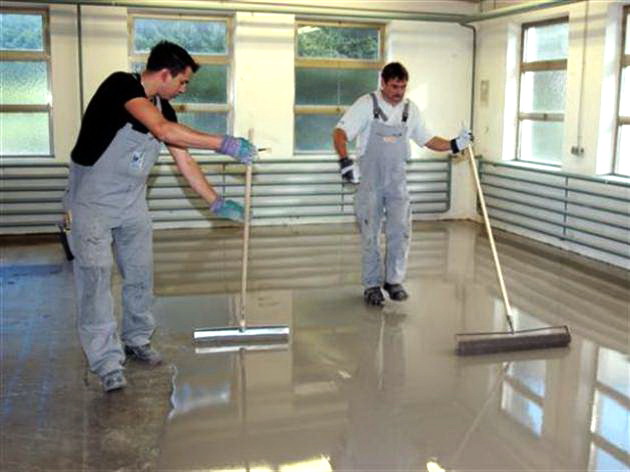
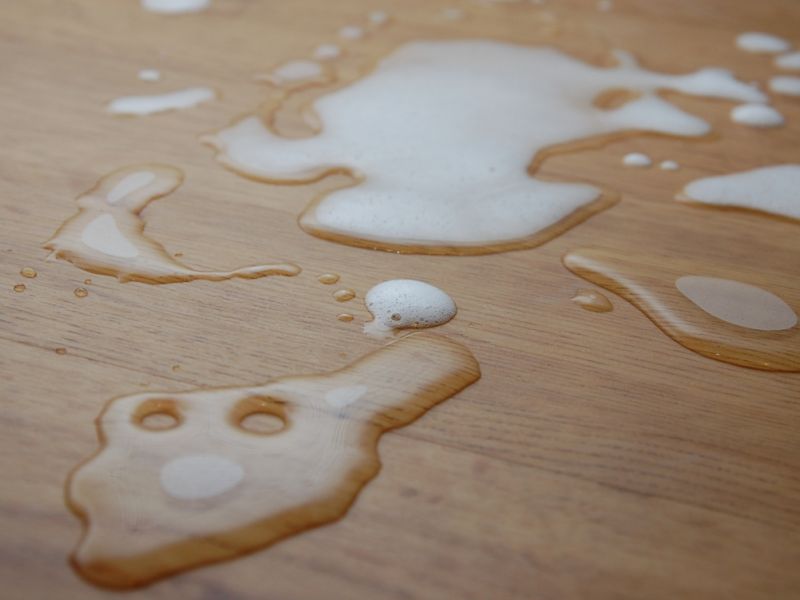
1 comment